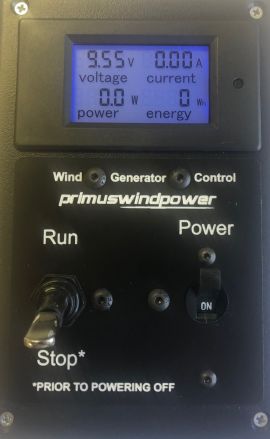PRIMUS WINDPOWER-WIND CONTROL PANEL–DIGITAL VERSION (WCP-D)


PRIMUS WINDPOWER-WIND CONTROL PANEL–DIGITAL VERSION(WCPD)
Primus Windpower 10 Amp Digital Wind Control Panel is compatible with Air 40 and Air Breeze 24 Volt wind turbines (for other AIR wind turbine model see list below). It allows the user to monitor and control the operation of the turbine in one location. The WCP-D is meant for indoor installation only.
Dimensions: 6.5 x 4.25 x 2.5 inches
The Digital Wind Control Panel features a LCD display that shows the operation status of the turbine such as battery voltage, production current, power and accumulated energy. The front of the panel also features a stop switch as well as a breaker to power the turbine on and off.
The connection terminals are clearly marked in the rear of the panel: turbine +/- and battery +/-. All Wind Control Panels are calibrated and ready to be wired.
There are 5 models of the Digital Wind Control Panel:
Model: 2-ARAC-D-5
5 Amp digital wind control panel for 48 Volt Air 40 and Air Breeze turbines
Model: 2-ARAC-D-10
10 Amp digital wind control panel for 24 Volt Air 40 and Air Breeze turbines
Model: 2-ARAC-D-20
20 Amp digital wind control panel compatible with 48 Volt Air 30, Air X Marine and Air Silent X turbines
Model: 2-ARAC-D-25
20 Amp digital wind control panel compatible with 24 Volt Air 30, Air X Marine and Air Silent X turbines
Model: 2-ARAC-D-40
40 Amp digital wind control panel compatible with 12 Volt Air 30, Air X Marine and Air Silent X turbines
WIND TURBINE INSTALLATION
PREPARING FOR A WIND TURBINE INSTALLATION STRING
One of the most important considerations is siting. General industry standard is 30 ft. above obstacles within 300 ft. Obstacles in the primary wind energy direction have an increased impact on the production of a wind turbine by altering the resource or increasing turbulence. There are multiple ways to help avoid this potential conflict, including siting the turbine in a more open area, locating the turbine upwind of obstacle(s) to the prevailing wind direction, or increasing the tower height. Poor siting not only affects production and wear and tear on the turbine, but also the experience and overall satisfaction of wind as a viable power generating source.
The distance from the tower to the battery bank needs to be taken into consideration. This will dictate the size, length, and therefore the cost of wire. Locating the turbine and tower should be thoroughly thought out with attention to: the ease of access between the two for possible trenching, potential traffic, direct burial cable or conduit, junctions or splices, and safety. The proximity to property lines and surrounding area to accommodate access to the turbine, whether the tower is tilted down, or serviced by a lift will also affect tower location.
TOWER OPTIONS
There are different types of towers onto which a wind turbine can be mounted. These include: lattice or truss type towers, stand-alone towers (monopole), guyed towers, and homemade. There are pros and cons associated with each as well as applications. Some considerations are:
- Lattice or truss type towers generally are climbable, can be assembled onsite, require concrete, a larger base footprint, and possibly guy wires.
- Stand-alone (pole) towers are generally more attractive, no guy wires, have height limitations, and require extensive foundation and concrete work prior to installation.
- Guyed towers are relatively inexpensive, easily raised and lowered, can be assembled onsite, but require a larger foot print.
TOWER ANCHORS
Towers that use guy wires and some lattice type towers will need to have anchors for guy wire attachment. The type of anchors that can be used will be dependent upon soil type –some installations may require a soil analysis. Types of anchors include:
- Augers – these are “screwed” into the ground
- arrow head with wire cable– these are driven into the ground and “set” so arrowheads are parallel with the surface
- concrete – set into the ground with augers, rebar, or eye bolts protruding for guy wire attachment
- pins – these are set, anchored, or driven into rock (similar to rock climbing anchors)
AMRtechnologies Solar & Electrical Systems
Tel: (+506) 2438-3246 or (+506) 2438-3272
Toll Free: 1(800) 2130227
Solar Systems in United States & Latin America
